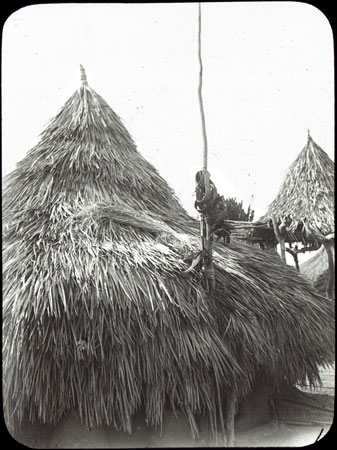Mandari (Tsera) shrine

82 x 82 mm | Lantern slide glass
MountDimension:
82 x 82 mm
Date of Print:
Unknown
Previous Other Number:
V.e.50 (456)
Accession Number:
1967.26.196
Description:
A homestead of the Tsera (called Shir by Seligman) sub-group of Mandari living on both sides of the Nile bank, with a post-shrine visible in the foreground attached to a hut.
The shrine seems to consist of a long pole with various attachments, probably remains such as horns from animals sacrificed to spirits, as well as bands of woven material.
Photographer:
Charles Gabriel Seligman
Date of Photo:
?1910
Region:
[Southern Sudan] Bahr el Jebel [vicinity of Nile]
Group:
Mandari (Tsera)
PRM Source:
London School of Economics and Political Science
Acquired:
Donated 1967
Other Owners:
C. G. Seligman slide collection
Class:
Ritual , Religion , Shelter
Keyword:
Shrine , Building House
Documentation:
Manual Catalogue in Related Documents File
Primary Documentation:
Accession Book Entry - [1967.26] THE LONDON SCHOOL OF ECONOMICS AND POLITICAL SCIENCE, HOUGHTON STREET, ALDWYCH, LONDON, W.C.E.
PER MR ANTHONY FORGE - SUDAN.
Box containing 309 lantern slides (3 1/4” x 3 1/4”) made from photographs taken by the late Professor C.
G.
SELIGMAN in various parts of the SUDAN.
All slides numbered and labelled.
Catalogue in file (“Seligman Slide Collection”).
Additional Accession Book Entry - [in pencil] 18 Parks Rd.
Manual catalogue entry (thermofax catalogue copy in folder '27-06 Seligman Slide Collection') - "V.e.50. Shir shrine (456)"
Note on lantern slide ms ink - "V.e.50. Shir shrine. 456. CGS."
Manual catalogue entry (thermofax catalogue copy in folder '27-06 Seligman Slide Collection') - "V.e.50. Shir shrine (456)"
Note on lantern slide ms ink - "V.e.50. Shir shrine. 456. CGS."
Other Information:
Ethnologue suggests that Shir should be treated as an alternative name within the Mandari language group, although they are separated by Seligman (1932).
Tucker (1935) also distinguishes them, suggesting that they are an offshoot of the Mandari.
They are undoubtedly closely related however.
[Chris Morton 15/10/2004]
Recorder:
Christopher Morton [18/10/2004] [Southern Sudan Project]

